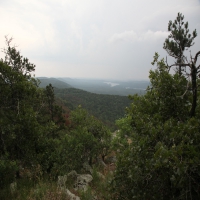
A mag survey show items with iron in them. Anything magnetic. The stronger the magnetic pull, the larger the ferrous item it is detecting and the larger the number recorded for the survey for that spot. So gold and silver are not picked up on a mag survey. If there is a close grouping of high number mag hits surrounded by other nearby items like an anchor, ballast stones and/or other items that point to a wreck site of a sunken boat. Those large mag hits indicate some big, like car size, that contains a huge amount of iron. A group of these spells out several cannons, just about the only thing it could be.
If a boat had several cannons on it, 20-60 for example, those wold be there to protect valuable cargo. This big grouping of hits coupled with cannon balls and stone cannon balls improves the chances of the items being cannons.
Stone cannon balls were less usual. There were used because they would break apart on impact and scatter sharp pieces of the stone on the deck. A lot of the crew on the boat were barefoot so this would create a bit of havoc on board the ship.
The layout of the ships would be in layers with ballast stones on the bottom of the boat, payload storage area above that level and cannons above that level.
At the expected date of this wreck, gold was still being shipped back in bars, not coins. Coins can spread out a lot and flitter about eventually, a few, ending up on the beach or found in shallow water. Like in Lantana. Coins reported over the years on the beach.
Bars, however, are heavy. They don't flitter. They sink and they don't move. Cover them with the iron cannons and 35 feet of sand the they will stay put for a long time.
The saying in the industry is "Find the cannons, find the gold."
Also the anchor "points" in the direction of the expected wreck spot. It would have been dragged and lay down with the top going in the direction it was dragged thus 'pointing' to the wreck site.
I think with this info you can see what happened here. A hurricane caused the boat to break from the first anchor, ballast stones come out of the bottom first, eventually it all sinks a short distance away in deep sand, gets covered up and stays there for 400 years. This also means there was no way for a return group could do any salvaging because of the depth and sand. In fact, it is still hard to do today. This means it will still contain the mother lode which should be in bars of gold.
Starting to get the picture?
